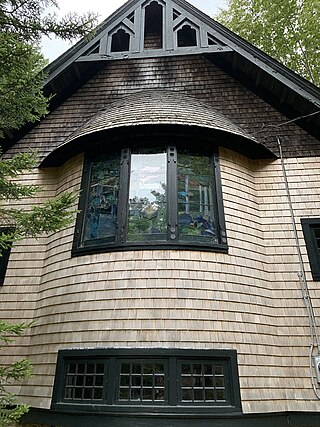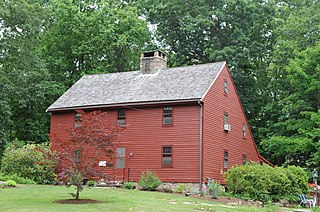
Branford is a shoreline town located on Long Island Sound in New Haven County, Connecticut, United States, about 6 miles (10 km) east of downtown New Haven. The town is part of the South Central Connecticut Planning Region. Branford borders East Haven on the West,Guilford on the East and to the north is North Branford. Branford is home to one of the Best 8th grade youth football teams in the SYFC.The population was 28,273 at the 2020 census.

Short Beach is a beach neighborhood situated in Branford, Connecticut. It is the westernmost of Branford's seven neighborhoods, the others being: The Hill, The Center, Pine Orchard, Stony Creek, Indian Neck, and Brushy Hill. Short Beach's population is approximately 2,500. About a half mile long, it is situated in New Haven County and is bordered by East Haven to the west, Branford to the north and east and Long Island Sound to the south. It is home to many small islands, the largest being Kelsey's Island which has a few small cabins used as summer homes.

The Stony Creek–Thimble Islands Historic District is a historic district encompassing a 19th-century summer resort area in Branford, Connecticut. Located in the southeastern part of the town, it encompasses the mainland Stony Creek neighborhood, and all of the major Thimble Islands which lie offshore from Stony Creek in Long Island Sound. The district includes a well-preserved array of domestic summer resort architecture spanning more than a century preceding World War II, as well as worker housing and other artifacts related to the area's brief importance as a granite quarry. The district was listed on the National Register of Historic Places in 1988.

The William J. Clark House is a historic house at 32 Prospect Hill in the Stony Creek neighborhood of Branford, Connecticut. Built in 1878–80 to a design by New Haven-based architect Henry Austin, it is a particularly fine example of the Stick style of architecture popular at the time. The house is individually listed for its architecture on the National Register of Historic Places as the Stick Style House at Stony Creek, and is a contributing property to the Stony Creek-Thimble Islands Historic District.

Northfield Union Church is a historic church on Sondogardy Pond Road in Northfield, New Hampshire. Built in 1883, it is a fine example of modest Carpenter Gothic architecture, designed by Edward Dow, one of New Hampshire's leading late-19th century architects. It was added to the National Register of Historic Places in 1984.

The Canaan Chapel is a historic chapel on Canaan Road in Barrington, New Hampshire. Built in 1881, it is a typical example of a rural Free Will Baptist church of the mid-19th century, exhibiting modest elements of Greek Revival design despite a late construction date for that style. The building was listed on the National Register of Historic Places in 1982.

The East Raymond Union Chapel is a historic chapel at 394 Webbs Mills Road in East Raymond, Maine. Built in 1890, it is a modest wood-frame building with Queen Anne and Gothic Revival styling. It has served as a non-denominational religious meeting place for much of its time; it is now affiliated with the United Church of Christ and the Casco Village Church in Casco. It has scheduled services during the summer. The building was listed on the National Register of Historic Places in 2004.

Saint Jude's Episcopal Church is a historic church at 277 Peabody Drive in Seal Harbor, Maine. Built in 1887–89, this Shingle-style church is the least-altered surviving example of ecclesiastical architecture in Maine designed by the noted exponent of the style, William Ralph Emerson. Principally used as a summer chapel, it is affiliated with the Episcopal mission of St. Mary's in Northeast Harbor. The building was listed on the National Register of Historic Places in 1986.

West Gouldsboro Union Church is an historic church on Maine State Route 186 between Jones Cove and Jones Pond in West Gouldsboro, Maine. Built in 1888–1891, it is a distinctive and eclectic example of Queen Anne Victorian architecture. The building was listed on the National Register of Historic Places in 1990.

The Branford House is located in Groton, Connecticut, on the campus of UConn Avery Point, which rents it out for events. Branford House was built in 1902 for Morton Freeman Plant, a local financier and philanthropist, as his summer home; he named it after his hometown of Branford, Connecticut. The house was added to the National Register of Historic Places on January 23, 1984.

The Elisha Seymour Jr. House is a historic house at 410-412 Park Road in West Hartford, Connecticut. Built about 1770, it is one of the town's few surviving pre-independence brick buildings. it was listed on the National Register of Historic Places in 1986.

The George Baldwin House is a historic house at 530 Foxon Road in North Branford, Connecticut. Probably built in the 1830s, its distinctive Greek Revival design has been attributed to architect Ithiel Town. The house was listed on the National Register of Historic Places in 1977.

The Samuel Beach House is a historic house at 94 East Main Street in Branford, Connecticut. Built about 1790, it is one of the town's modest number of surviving 18th-century houses. It was listed on the National Register of Historic Places in 1988.

The Blackstone House is a historic house at 37 First Avenue in Branford, Connecticut. Built in the second quarter of the 18th century, it is one of Branford's modest number of surviving 18th-century houses, and a well-preserved example of the Second Period of colonial construction. It was listed on the National Register of Historic Places in 1988.

The Edward Frisbie House is a historic house at 699 East Main Street in Branford, Connecticut. Probably built about 1750, it is a fine local example of Georgian residential architecture, historically attributed to one of the area's early settlers. It was listed on the National Register of Historic Places in 1988.

The Orrin Hoadley House is a historic house at 15 Sunset Hill Road in Branford, Connecticut. Built about 1785, it is a good example of late colonial residential architecture, and one of the town's modest collection of 18th-century buildings. It was listed on the National Register of Historic Places in 1988.

161 Damascus Road is a historic house in Branford, Connecticut. Built about 1750, it is a well-preserved example of mid-18th century colonial residential architecture. It was listed on the National Register of Historic Places in 1988.

29 Flat Rock Road is a historic house in Branford, Connecticut. Probably built in the late 18th century, it is a well-preserved example of a modest period farmhouse, a type of which relatively few now survive in the town. It was listed on the National Register of Historic Places in 1988.

The Norton House is a historic house at 200 Pine Orchard Road in Branford, Connecticut. Built about 1715 in what is now Madison, it is one of Branford's small number of well-preserved 18th-century houses. It was moved to its present location about 1940, and was listed on the National Register of Historic Places in 1988.

The Solomon Tyler House is a historic house at 260-268 East Main Street in Branford, Connecticut. Built about 1770, it is one of the town's few surviving 18th-century residences, and good example of Georgian architecture. The house was listed on the National Register of Historic Places in 1988.






















